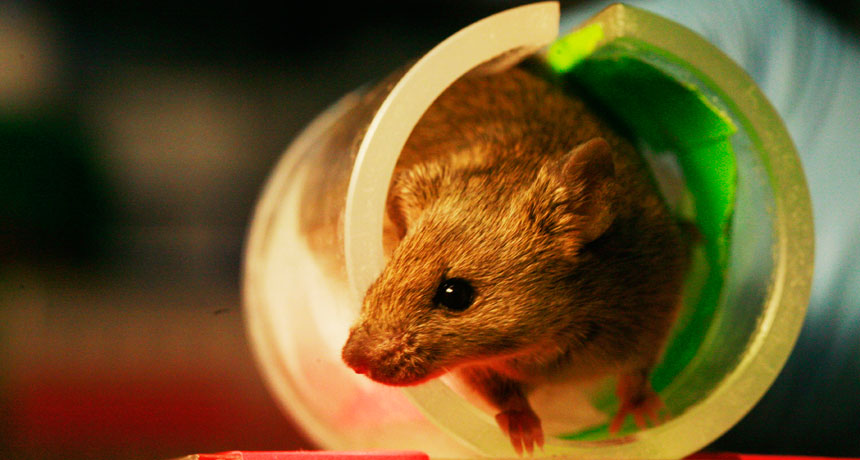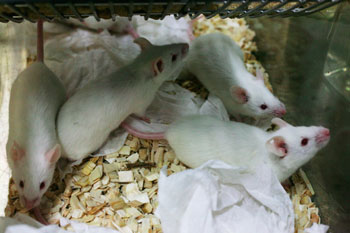Some pollutants made mice less friendly
By studying the effects of certain pollutants in mice, scientists probed risks they might also pose to people

Watching how mice behave after exposure to certain chemicals could help scientists learn how those chemicals might affect people.
Rama/Wikimedia Commons (CC-BY-SA 2.0)
By Tara Haelle
The body’s endocrine system makes hormones. Like a band director’s baton, those hormones signal cells when and how to perform. But some chemicals can mimic — or sometimes block — the activity of these hormones. Like a fake band director, these hormone imposters might send out false directions. Many such hormone-like chemicals leach out of plastics, cosmetics, packaging materials and more. A mouse study now finds signs that some of these common pollutants indeed can issue false signals.

Alexander Suvorov studies environmental health at the University of Massachusetts in Amherst. He had become curious about why rates of two brain disorders seem to be on the rise. The first is autism. It affects how someone experiences the world and interacts with it. The second condition is ADHD, or attention deficit hyperactivity disorder. People with ADHD have difficulty concentrating and staying still.
Suvorov wanted to test in mice whether pollutants might cause or intensify behaviors typical of autism or ADHD. If the chemicals did, that might explain recent increases in the number of people diagnosed with the disorders.
For its new study, Suvorov’s team exposed pregnant mice to high doses of one of three common chemicals. They were bisphenol S (Bis-FEE-nul S), BDE-47 and TBBPA. Bisphenol S is used in some clear plastics and papers used to make cash-register receipts. BDE-47 and TBBPA are flame retardants. Companies no longer use BDE-47, though. Scientists suspect it may have harmful health effects in people. The dose of BDE-47 given to mice in the study was similar to the amount that studies have shown has accumulated in the bodies of humans, Suvorov says. And everyone is exposed to TBBPA. That’s because it is now one of the most widely used chemicals for making materials fire resistant.
Each of the three chemicals can affect hormones. Scientists call such chemicals endocrine disruptors . For instance, BPS can work like a weak version of estrogen. That’s the body’s primary female sex hormone.Mice were exposed to different of these chemicals in the womb. Later, as adults, the mice encountered a stranger mouse. Mice that had been exposed to a pollutant now moved more quickly around the stranger than unexposed animals did. This suggests the exposed animals felt anxious, Suvorov says. Indeed, mice exposed to these chemicals avoided the stranger mice and spent more time alone. In contrast, mice not exposed to any of the three chemicals sniffed strangers longer and acted friendlier.
The new study also found that weight affected how social a mouse was. That is a measure of how comfortable it was around others of its kind. Heavier mice had a lower status. They tended to be less popular or attractive to others. Skinnier mice were more dominant. The scientists also found some hints that the chemicals they worked with could affect body weight.
A bigger study is needed to confirm the new observations. But if they are confirmed, then these pollutants may have the ability to indirectly affect an individual’s social status.
That could be very important, Suvorov says. “It has never been shown in animals before that having a higher body weight also means it will be subordinate,” that is, lower in rank or position.
What about people?
It is still too early to people might respond similarly, Suvorov says. In fact, no data exist to show these chemicals have any effect on human behavior.
Still, the new tests have begun to probe what types of changes to look for in people. For instance, Suvorov wonders if exposures to such chemicals might slightly change how people interact.
“Let’s imagine that everybody in our society is now 10 percent more aggressive,” he says. That small change would make little difference in one individual. But if everybody was affected, “then the whole society may function differently,” he says.
Like the mice in the study, overweight people in many societies may be shunned or less popular, said Robert Schwartz. A retired doctor in Wake Forest, N.C., his work focused on hormone effects in children. But, Schwartz notes, people are exposed to many endocrine disruptors. They can be found throughout the environment and in our diets. So, he says, “It’s hard to say that at the lower levels that humans are exposed to, that these chemicals have significant effects.”
Power Words
(for more about Power Words, click here)
attention deficit hyperactivity disorder (ADHD) This is a disorder characterized by not being able to focus or pay attention, being physically overactive, not being able to control behavior, or a combination of these.
autism (also known as autism spectrum disorders) A set of developmental disorders that interfere with how certain parts of the brain develop. Affected regions of the brain control how people behave, interact and communicate with others and the world around them. Autism disorders can range from very mild to very severe. And even a fairly mild form can limit an individual’s ability to interact socially or communicate effectively.
BDE-47 An abbreviation for a commercial flame retardant known as polybrominated diphenyl ether-47. Manufacturers agreed to phase out this chemical’s production after studies showed residues of the material were accumulating in the bodies of mammals — including people. Studies also showed that the chemical had hormone-like effects in wildlife and lab animals.
behavior The way a person or other organism acts toward others, or conducts itself.
bisphenol S (BPS) A building block of some plastics and commercially important resins. Manufacturers began to substitute this compound for a chemical cousin — bisphenol A, or BPA — when research showed BPA mimicked the hormone estrogen and could provoke a number of adverse effects in laboratory animals. Later research would show, however, that BPS also can exert mild hormone-like qualities in mammals.
chemical A substance formed from two or more atoms that unite (become bonded together) in a fixed proportion and structure. For example, water is a chemical made of two hydrogen atoms bonded to one oxygen atom. Its chemical symbol is H2O.
endocrine disruptor A substance that mimics the action (sometimes well, sometimes poorly) of one of the body’s natural hormones. By doing this, the fake hormone can inappropriately turn on, speed up or shut down important cellular processes.
endocrine system The hormones (chemicals secreted by the body) and the tissues in which they turn on (or off) cellular action. Medical doctors who study the role of hormones in health and disease are known as endocrinologists. So are the biologists who study hormone systems in non-human animals.
endocrinologists Doctors who specialize in conditions affecting the production of hormones or the body’s response to hormones.
environment The sum of all of the things that exist around some organism or the process and the condition those things create for that organism or process. Environment may refer to the weather and ecosystem in which some animal lives, or, perhaps, the temperature, humidity and placement of components in some electronics system or product.
estrogen The primary female sex hormone in most higher vertebrates, including mammals and birds. Early in development, it helps an organism develop the features typical of a female. Later, it helps a female’s body prepare to mate and reproduce.
flame retardants Chemical coatings added to products, such as pyjamas, plastics, foam and furniture, to suppress or delay how fast they might burn in a fire.
hormone (in zoology and medicine) A chemical produced in a gland and then carried in the bloodstream to another part of the body. Hormones control many important body activities, such as growth. Hormones act by triggering or regulating chemical reactions in the body. (in botany) A chemical that serves as a signaling compound that tells cells of a plant when and how to develop, or when to grow old and die.
obesity Extremely overweight. Obesity is associated with a wide range of health problems, including type 2 diabetes and high blood pressure.
social Of or relating to a group of people or animals and how members of their community have organized themselves and interact. For instance, very social animals are those that choose to hang out around others. Social anxiety can describe individuals who become scared or easily bullied by individuals who are stronger or more self confident.
social order The system of values, practices, institutions and rules that guide the behaviors of an integrated group of people or animals.
status The relative position or standing of an individual within a group or population. Popularity, wealth, size, physical attractiveness, accomplishments and power can all increase the status of an individual by making him or her seem impressive and valued.
subordinate Someone or something that is lower in rank, based on power, importance, value or some other characteristic.
TBBPA An abbreviation for tetrabromobisphenol A. This chemical is a brominated form of bisphenol A (BPA), a building block of resins and plastics. But unlike BPA, TBBPA is now widely used as a flame retardant. It can enter the body through contaminated foods or by passing directly through the skin.
womb Another name for the uterus, the organ in which a fetus grows and matures in preparation for birth.







